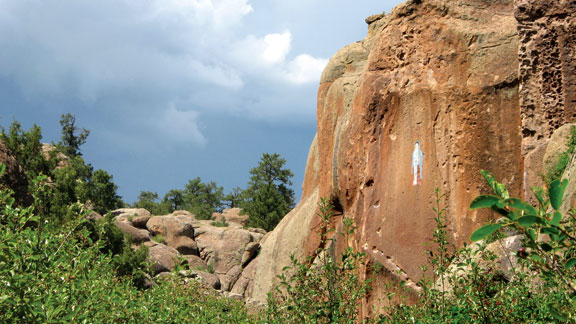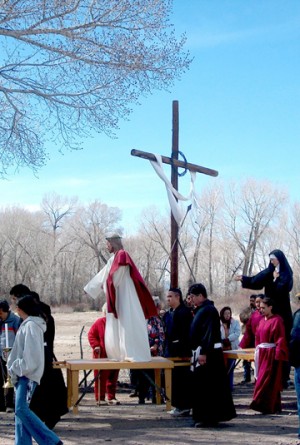by Mike Rosso
A fascinating history, unique geology and extreme recreation can all be found in the recesses of Penitente Canyon, on the western edge of the San Luis Valley in Saguache County.
Located just outside the village of La Garita, the canyon was originally know as Cañon de Rajadero (Woodsplitter Canyon), after a pit sawmill located there in the 1800s. (This involved a person standing in a pit operating one end of a two-handled saw with another standing above the log on the other handle.) Old wagon tracks can be also found embedded in the rocks within the colorful canyon — remnants of wood gathering activity from that time period. Lumber milled in the canyon was used to build the original Catholic church in La Garita which has since burned down.
Pictographs (painted panels) discovered there depict game drives through the canyon pre-dating even the Spanish settlement of the area. Angie Krall, an archeologist with the U. S. Forest Service and Bureau of Land Management (BLM), believes the panels were created by either Puebloan, Apache or Ute tribes. The agencies are drawing up plans to preserve the quickly fading ancient art. The canyon, which is now managed by the BLM, was once part of the vast Guadeloupe Land Grant — Spanish lands that were lost to the U.S. during the Mexican American War.
[InContentAdTwo]
Other rock art found in the canyon depicts what may have been a large “net” set up at a narrow location in the canyon designed to trap game chased between the high rocks by native hunters, according to Del Norte, Colorado native, Alex Colville, who has been exploring the canyon for much of his 77 years. It was Colville who helped establish some of the original rock climbing routes in the 1980s for which the canyon is best known today.
For a time the canyon was also known as Capulin Canyon, named for the chokecherry bushes found there in abundance, but it was a daring act by three Hispanic men in the early 1980s which led to the name by which the canyon is now known. The men, members of the Penitente church who lived in the area, decided to paint a mural to honor the Virgin of Guadalupe, whose image, it is said, miraculously appeared on the cloak of an indigenous peasant near Mexico City in 1531, and who is highly revered by Mexican Catholics.

The story has it that the men tied their three lariats together and attached them to an old tire which was lowered over the canyon wall and held both painter and the cans of paint. Using a pallet of red, blue, black and white, they rendered the likeness of the Virgin against the red rock high up above the canyon floor. Atop the mural they painted in red the words “Con Sufrimiento y Consuelo” which translates to “With Suffering and Consolation.” Others have suggested the faded words read “Consuelo y Espiritu” (Comfort and Courage).
The men also painted their names on the rocks at the base of the mural — Victor, Abel and Victor — signatures which are quickly fading due to erosion and weathering. But it didn’t take long before a drunk man with a pistol decided to use the painting for target practice and shot it up, completely obliterating the face and leaving pockmarks in and around it. Alex Colville tells of two climbers, Tom Helvie and Anna Kekesi, who rappelled down the wall and plastered the bullet holes, but were unable to restore the face of the Virgin.
It was around 1918, when nearly half the town of La Garita fell victim to a deadly flu virus, that several societies of Los Hermanos Penitente were established in the area. Very little remains of the moradas (chapels) in the area where they once worshipped. Evidence has suggested the Pentitentes had, on occasion, used the canyon for Easter ceremonies, but with its newfound popularity as a climbing destination that use has subsided.
The canyon itself is part of the La Garita Caldera, a volcanic eruption that occurred in the San Juan Mountains about 26-28 million years ago. It is said to be the largest known explosive eruption in the Earth’s history, sending ash as far off as the U.S. Eastern Seaboard. The resulting deposit is called Fish Canyon Tuff, which is volcanic ash molded together, according to Colville. The resulting geological formations are ideal for the sport of rock climbing.


